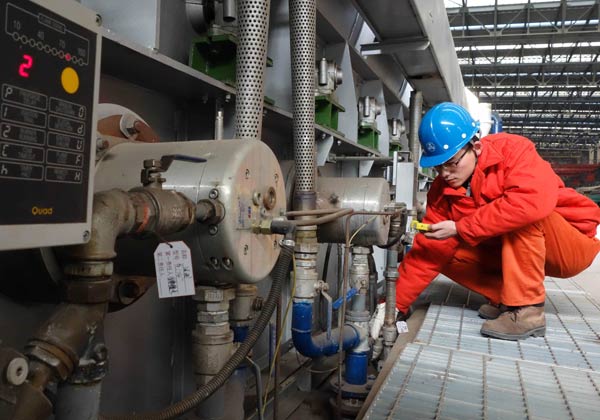

Figures are seen as strong evidence of stabilization in the economy
|
 |
| A worker examines the gas supply system at a specialty steel plant in Dalian, Liaoning province. From January to October, large industrial enterprises' profits rose 13.7 percent year-on-year. Liu Debin / For China Daily |
Industrial companies saw their profits rise 15.1 percent year-on-year in October, slowing from the 18.4 percent growth seen in September, official data showed on Thursday.
The total profits of industrial companies with annual revenue of more than 20 million yuan ($3.3 million) reached 581.04 billion yuan in October, the National Bureau of Statistics said.
In the first 10 months, industrial companies' profits rose 13.7 percent from the same period last year to 4.63 trillion yuan, accelerating from the 13.5 percent growth seen in the first nine months.
Among the 41 industries surveyed, 35 posted year-on-year profit growth in the January-October period and five saw profits decline, while the oil refining, coking and nuclear fuel processing sectors turned losses into gains, the NBS said.
Private companies led the growth, with their combined profits up 17.5 percent year-on-year in the first 10 months, while State-owned enterprises saw profits rise 9.1 percent during the same period.
The five industries with the highest profits are the electricity, heating power production and supply sector with year-on-year profit gains of 106.65 billion yuan, the motor industry with gains of 72.53 billion yuan, the oil processing, coking and nuclear fuel processing industry with gains of 53.65 billion yuan, the nonmetal mineral products industry with 49.25 billion yuan in gains, and the metal smelting industry with gains of 42.1 billion yuan. The five industries contributed 58.1 percent of all the newly increased profit of the sampled 41 industries.
The steady growth in industrial profits is the latest evidence pointing to a stabilizing economy.
Previous NBS data showed that China's Purchasing Managers' Index for the manufacturing sector rose to an 18-month high of 51.4 in October, the fourth consecutive increase in as many months.
HSBC Holdings Plc's preliminary manufacturing PMI figure for November, which was released last week, eased to 50.4 from a seven-month high of 50.9 in October. Qu Hongbin, chief China economist at HSBC, said that although the country's growth momentum softened a little in November, the bank is "still optimistic about the country's growth prospects in the short term".
Chinese shares were relatively strong on Thursday, partly due to the upbeat data, with the benchmark Shanghai Composite Index rising 0.83 percent to 2,219.37 points.
However, despite the overall rosy data, China has seen a continuous decline in the average profit margin of companies since 2010.
According to Miao Wei, minister of industry and information technology, the average profit margin of companies in the country fluctuated between 6 percent and 7 percent after 2002 and started dropping after 2010.
"The rate was only 5.4 percent in the first half of this year, 28.9 percentage points lower than in 2010," Miao said.
The profit margin gaps between the resource-related and manufacturing industries and the financial and real estate sectors are testimony to the difficulty of China's restructuring efforts.
The profit margin in the real estate sector is about twice that of the resource-related and manufacturing industries, while the profit margin of the banking sector in 2011 was 39.1 percent, five times that of the resource-related and manufacturing industries.
"The high profits of the financial, real estate sectors and monopoly resource industries raise the financing and operation costs of the real economy, dampen private capitals' zeal for industries and sap the driving forces for industrial enterprises' upgrading and restructuring," Miao wrote in an article.
Innovation has been a long-lasting bottleneck for Chinese industries.
Analysts believe that innovation in core, cutting-edge and basic industrial technologies is central to reverse the tide, among the many other structural adjustment endeavors of the government.
There already are some key technological innovation projects supported by the government, such as new generation wireless mobile networks, advanced numerically controlled machine tool and basic manufacturing equipment and large airplanes.
Overcapacity is another challenge that China must tackle to be able to improve its industrial performance and sustainability.
Since the 4 trillion yuan stimulus package launched by the government in 2008, the country's heavy industry has seen significant funding, which has caused serious overcapacity in the iron and steel, photovoltaic and calcium carbide industries.
The capacity utilization rates of the crude steel, electrolytic aluminum, cement, plate glass and shipbuilding sectors are all below 70 percent this year.
Insiders said that the government should tighten market entry criteria to set up a long-term mechanism to prevent overcapacity.
"The government should stop investments, loans and preferential policies for land and taxes for industries with overcapacity", said Miao Changxing, deputy director of the industrial policy division of the Ministry of Industry and Information Technology.
Xinhua contributed to this story.
 Buick Riviera concept car at 2013 Auto Guangzhou
Buick Riviera concept car at 2013 Auto Guangzhou
 FAW-VW all-new Golf at Guangzhou auto show
FAW-VW all-new Golf at Guangzhou auto show
 VW donates more than 5k child safety seats
VW donates more than 5k child safety seats
 Honda models at 2013 Guangzhou auto show
Honda models at 2013 Guangzhou auto show
 Honda Jade at the 2013 Guangzhou auto show
Honda Jade at the 2013 Guangzhou auto show
 Toyota's new Reiz debuts at 2013 Auto Guangzhou
Toyota's new Reiz debuts at 2013 Auto Guangzhou
 Jimmy Lin Zhiying, models at Toyota pavilion
Jimmy Lin Zhiying, models at Toyota pavilion
 Volvo all-new S60L world premiere at Guangzhou auto show
Volvo all-new S60L world premiere at Guangzhou auto show